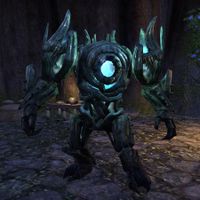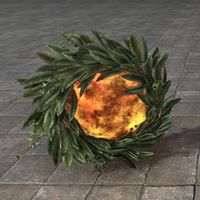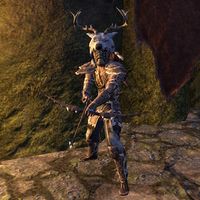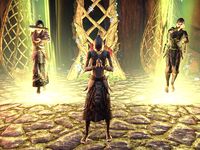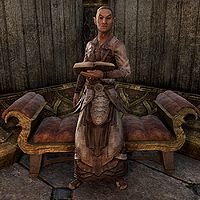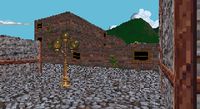Lore:Silvenar
This article is about the city. For the person, see The Silvenar.
| Silvenar | |
|---|---|
| Type | Settlement |
| Continent | Tamriel |
| Province | Valenwood |
| Region | Malabal Tor (Silvenar Vale) |
| Demonym(s) | Silvenari[1] |
| Appears in | Arena, ESO |
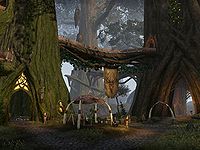
|
Silvenar is one of the eight major cities in the province of Valenwood,[2] situated in the primordial jungles of Malabal Tor as its capital.[3] The city is known for its unrivaled beauty[4] and magnificent shades of colored trees, combined with an intricate web of translucent amber.[5] It is a holy city and residence of the Silvenar, the spiritual leader of the Bosmer and the embodiment of the Green Pact.[6] It is unknown whether the city came first or the person.[7]
Layout and Geography[edit]
Silvenar is one of the several cities built from the mighty Graht-oak,[8] seasonal, migratory trees that are prevalent across the province and have since rooted throughout the land. It has rooted somewhere in the heart of Valenwood, on the banks of the Xylo River,[5] but some sources claim that Silvenar is perched on the edge of Elden Grove.[4] Like other graht-oak cities, Silvenar is divided between the common dwellings on the forest floor occupied by the other races and the high canopies where the Wood Elves typically lived.[8]
There are tall minarets and spires built from marble that rise above the tree-top,[4] whereas, the streets and bridges of Silvenar are coated in its signature amber.[5] In the mid-Second Era, the graht-oak was excavated by the Ebonheart Pact, who created tunnels underneath the city called the Roots of Silvenar.[9] The city is rooted high above the ground and surrounded by a ravine populated by forest creatures like Senche-Tigers. The only way into the city is through a large bridge that goes over the ravine and onto a platform, where a bound Lurcher spirit called the Guardian of Silvenar guards the city.[10][11]
The ground floor is an open circle centered around the largest tree, known as the Great Tree. Three smaller trees surround the circle and have bridges connected to each other.[10] The Silvenar's Audience Hall, found in the Palace of the Silvenar is located in the highest canopy of the city. It is described as an enormous dome that meets at the top and thin rays of light come down. The palace itself is made of twisted and uneven spires of scarlet, like a sunrise. The bridge to the palace is bent and petal-like.[12] Silvenar is neighbored by several settlements, including Black Park to the west, Ebon Ro to the northeast, Longvale to the southwest, Meadow Run to the south, Moonmont to the southeast, Stone Fell to the east, and Vulkwasten Wood to the north.[2]
Notable Locales[edit]
|
|
History[edit]
Early History[edit]
Silvenar is one of the graht-oak cities of Valenwood, which all represent the mythical Tower of Green-Sap.[13] There is a myth surrounding Silvenar's founding. The city was once a blossoming grove until through some spell or natural cause, the tree sap started to flow en masse a translucent liqueur over the colorful trees and it formed the city that we know today.[5] The earliest records of the settlement come from the Merethic Era, when it flourished with trade from the vast city-state at the White-Gold Tower, along with other settlements like Ceyatatar and Woodhearth.[14]
In these early days, Silvenar was a settlement independent from the other tribes. That was until the tribes were united under King Eplear, who first founded the Camoran Hegemony in 1E 0. Each of the tribes was ruled by their own Treethane.[15] It is unknown what came first, the city of Silvenar or the person called the Silvenar, but what is known is that before them, there was chaos that was soon followed by generations of "organized mayhem."[7]
Silvenar and the rest of Valenwood served under the Camoran Dynasty until in 1E 2714, when the Second Empire had fully conquered Valenwood, with help from the Colovian West. To ensure the province could never retaliate, the Empire greatly diminished the Camoran Dynasty's influence and shifted power to the treethanes. In Silvenar, this power was given to the Bosmer of House Rayn. By swearing allegiance, sometimes begrudgingly to the Empire, they were granted independence from other nations and thus turned Silvenar into a fully-fledged power in its own right.[15][16]
Throughout this era, five out of seven of Silvenar's treethanes were from House Rayn, and when the Empire dissolved in 2E 430, they had the potential to unite the Bosmer. However, unlike the Camorans of Elden Root, who made this attempt with great success, House Rayn looked inward and sought to create a coalition of like-minded clans that held traditional values. Despite this, when the Blacksap Rebellion occurred in 2E 489, Treethane Ubarion Rayn had no choice but to support King Aeradan Camoran instead of his cousin, Gelthior who held similar traditionalist views.[16]
The Silvenar and the Hound[edit]
During the Interregnum in 2E 582, Ulthorn the Hound marched into the city with a proclamation. On the eve of the handfasting ceremony for the Silvenar and the Green Lady, he denounced the Silvenar and spread propaganda across the masses in an attempt to recruit them to his cause.[17] Many people began to pledge their loyalty to the Hound, but some people like the city's treethane, Thalrinel showed resistance and was promptly punished.[18]
The Hound had then forced the three great spinners, Caerllin, Dothriel, and Einrel to create a barrier around the city from their woven memories. The Hound retreated to the Silvenar's Audience Hall, where he started the handfasting ceremony with the possessed Green Lady, Gwaering.[11] After being rescued from the confines of Jathsogur, the current Silvenar at the time, Indaenir led the retaking of the city with his allies from the Aldmeri Dominion.[19]
An Agent of the Dominion broke down the barrier and defeated the Guardian of Silvenar, opening the city to the Dominion. They soon freed each of the spinners from their prisons across the upper tier of the city and eventually made their way to the Silvenar's Audience Hall. They interrupted the ceremony but were forced to defeat the Green Lady and kill the Hound. With the Hound defeated, the Silvenar and the Green Lady went forward with the ritual, and their bond formed.[19] However, on their way to the ceremony, the Mane, Akkhuz-ri became corrupted by evil magic and attacked his entourage. He had soon fled to Reaper's March, near Fort Grimwatch, and the Agent was sent to follow suit.[20]
Around that same time, Nantharion Rayn, after regaining memory of his ancient patron, Ithelia, formed a group called the Recollection and used a greenspring seed corrupted with daedric magic called a wildburn seed to create a new forest in the Strid Vale called the Dawnwood.[21] Nantharion then led his people, followers of the Green Pact and Dawnway from Silvenar and created a settlement called Vashabar, where he declared himself king.[16][22][23] Though he preferred Queen Ayrenn over other Altmer, he was not invested in the Three Banners War and left it behind.[24]
Silvenar in the Third Empire[edit]
When Valenwood was inducted into the Third Empire, Silvenar became the center of its own kingdom, since at least the reign of Emperor Pelagius Septim I. When he passed away in 3E 41,[25] the former Queen of Silvenar, Kintyra I became his successor.[26] It was well known that the King of Solitude, Pelagius III often locked the prince and princesses of Silvenar in his room and only released them if an unsigned declaration of war was slipped through the door.[27] During the Imperial Simulacrum in the late Third Era, the city-state of Silvenar was an active settlement. It was ruled by King Paligorn and had a rivalry with several cities, namely Arenthia, Eldenroot, and Falinesti.[4]
Known Rulers[edit]
- For a list of Silvenars and Green Ladies, see previous holders of the title in the following articles: The Silvenar and The Green Lady.
The Silvenar and their companion, the Green Lady have always been associated with the city. Still, these two only reside in the city,[7] while the treethane handles the city's administration.[16][18][28] Since the beginning of the First Era, the Camoran Dynasty employed treethanes who governed their respective tribes. When the Second Empire took over Valenwood, all the power was shifted to them and their independent realms.[15] By the time the Third Empire united the provinces, Silvenar was ruled by a King/Queen.[4][26]
- The First Era — Starting from Emperor Reman I's reign, specifically 1E 2714, House Rayn had ruled Silvenar as its Treethanes.[15][16]
- The Second Era — Throughout the Akaviri Potentate period in the first half of the Second Era, five out of seven Treethanes in Silvenar were from House Rayn.[16]
- The Third Era
Culture and Society[edit]
As the myth goes, a vast flow of Graht-oak sap flowed through and formed the present-day city.[5] At the behest of the Silvenar, the graht-oak can produce sap, which gets crystallized and turned into Silvenari Sap-Stones.[29] The city has a municipal seal and green, iridescent wax is used to seal this symbol on letters. The Silvenar also uses this seal for official decrees.[30][31] Plum colored eyeshadow is a favorite among Wood Elves in Silvenar.[32]
There is an evident confusion between the names of the city and the person, which is typical nomenclature in Valenwood. For local translators, differentiating the two can be challenging.[5] A long-established mystery is whether the city or the person came first, but most people do not care.[7] With the Silvenar living in the central tree of the settlement, the three greatest spinners of the province live in the trees surrounding it. Each of them represents an aspect of time; the past, present, and future respectively. By the mid-Second Era, between the reigns of Silvenar Edhelorn and Indaenir, these spinners were Einrel (Future), Caerllin (Present), and Dothriel (Past).[11] The latter two are members of a noble house of the same name.[33][34]
Along with these established houses, other notable families live in Silvenar. One such group was House Rayn, an old and honorable clan of highborns that once ruled the city during the Reman Era.[16] The Silvenar Rangers was a competitive team that played Mammoth-Ball. They were champions in 2E 565 and their trophy, a tattooed hairy leather ball was in circulation across Tamriel by 2E 582.[35]
Gallery[edit]
Notes[edit]
- Arena was originally conceived as a fighting game featuring a tournament that took the player to each of Tamriel's cities to challenge different gladiatorial teams. According to a file from that stage of development left behind in the final game, Silvenar's gladiatorial team would have been called "the Rangers".[UOL 1]
See Also[edit]
- For game-specific information, see the Arena and Elder Scrolls Online articles.
Books[edit]
- A Time of Troubles by Gwilgoth Branchbreaker — A lesson on well-placed loyalty
- Arboreal Architecture by Cirantille — A description of Bosmeri construction techniques
- House Rayn of Silvenar by Beragon of Valenwood, Imperial Scribe — An overview of an old Bosmer noble family
References[edit]
- ^ Silvenari Sap-Stone antiquity codex entries in ESO: Greymoor
- ^ a b Map of Valenwood – The Elder Scrolls: Arena
- ^ Malabal Tor loading screen text in ESO
- ^ a b c d e f Silvenar location and rumors in Arena
- ^ a b c d e f g h A Dance in Fire, Chapter 5 — Waughin Jarth
- ^ Diplomacy during the Handfasting
- ^ a b c d The Voice of the People
- ^ a b Arboreal Architecture — Cirantille
- ^ a b Roots of Silvenar in ESO
- ^ a b c d e Silvenar in ESO
- ^ a b c d e Indaenir's dialogue in ESO
- ^ a b A Dance in Fire, Chapter 6 — Waughin Jarth
- ^ Aurbic Enigma 4: The Elden Tree — Beredalmo the Signifier
- ^ Ayleid Cities of Valenwood — the Esteemed Historian Homfrey at the University of Gwylim, 2E 455
- ^ a b c d Pocket Guide to the Empire, 3rd Edition: The Wilds Remain: Valenwood — Imperial Geographical Society, 3E 432
- ^ a b c d e f g h House Rayn of Silvenar — Beragon of Valenwood, Imperial Scribe
- ^ Reward for Information: Silvenar — Ulthorn the Hound
- ^ a b c d A Time of Troubles — Gwilgoth Branchbreaker
- ^ a b c Restore the Silvenar story quest in ESO
- ^ The Dark Mane story quest in ESO
- ^ Beragon's dialogue in ESO: Gold Road
- ^ Laeni's dialogue in ESO: Gold Road
- ^ Greenspeaker Darolith's dialogue in ESO: Gold Road
- ^ King Nantharion's Gambit story quest in ESO: Gold Road
- ^ a b The Third Era Timeline — Jaspus Ignateous
- ^ a b c Brief History of the Empire v 1 — Stronach k'Thojj III
- ^ The Madness of Pelagius — Tsathenes
- ^ The Wood Elves of Valenwood
- ^ Silvenari Sap-Stone antiquity codex entries in ESO: Greymoor
- ^ Great Seal of Silvenar treasure text in ESO
- ^ Green "Official Decree" Inkwell treasure text in ESO
- ^ Plum Color Eyeshadow in ESO
- ^ Bosmeri Noble's Omnium-Gatherum treasure text in ESO
- ^ Noble's Comb and Brush Set treasure text in ESO
- ^ Tattooed Mammoth-Ball Trophy treasure text in ESO
Note: The following references are considered to be unofficial sources. They are included to round off this article and may not be authoritative or conclusive.

